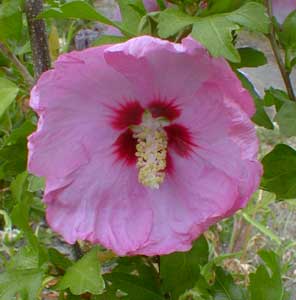
'Aphrodite'
Rose of Sharon,
or Pink Shrub Althaea
Thomas Jefferson grew the Rose-of-Sharon at all his homes. It remained one of the most popular ornamental shrubs in America throughout the Victorian Age & up to the second world war. In light of rapidly increasing types of shrubs available through the last half of the 20th Century, that old stand-by Rose-of-Sharon seemed for some while to have been displaced from the public consciousness. The development of newer compact cultivars has revived its popularity for the 21st Century.
'Aphrodite' is a hybrid of two earlier cultivars, H. syriacus 'Sokobeni-yae' x 'William R. Smith.' It was developed beginning in 1971 by Donald R. Egolf of the U.S. National Arboretum, & released to gardeners in 1988. They were bred for compactness, drought hardiness, resistance to pollution so that it is a suitable roadside shrub, & extended bloom period that runs from June through September. In 2002, ours had one bright bloom remaining on it as last as mid-October.
The species is native of China & India, even though it was named syriacus at a time when specimens in Europe were inaccurately believed to have orignated in Syria. The natural growth pattern is as a multi-stemmed upright vase shape, which may begin to "fountain" with age if never pruned. It can also be pruned & trained as a single-trunked little tree.
'Aphrodite' is most often six to eight feet tall, but can grow to ten feet & if not pruned to remain narrower, can reach outward to a six foot width. Cold hardy at minus 20 to 10 degrees, it suited to USDA zones 5-9. It should be fertilized with restraint as overfeeding gets only a lusher leaf growth rather than better flowers.
Though it will adapt to a little shade, really it needs full sun to bloom most spectacularly. Ours is in an increasingly lush streetside sun-garden where it becomes very leafy early in spring & gets all the water it requires from rainfall alone, until high summer when supplemental watering would be helpful. Actually, its drought hardiness is sufficient that its leaves show little or no sign of stress even if barely watered at high summer, but blooms bake off the branches quickly if it isn't watered at all, so occasional deep watering is best whenever there are long rainless hot days.
'Aphrodite's' blooms are 3 to 4 inch wide singles, rosy pink with magenta throats. The wild form of the Rose of Sharon can self-seed aggressively in conditions it adores, but the majority of the cultivars seed poorly if at all & 'Aphrodite' in particular is completely sterile. For other althaeas that do seed, the small pods cling to the naked branches until at some point in winter they burst their casings to sew the easily germinated seeds in the vicinity, there being no leaves on the branches at this time so that the seeds will toss themselves as far as possible without interference.
A Meditation Upon
the Mythology of the Rose of Sharon
& see
Hybiscus syriacus 'Blue Bird'